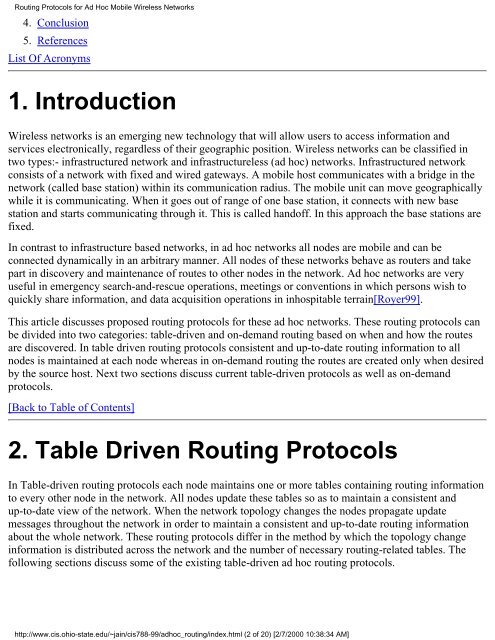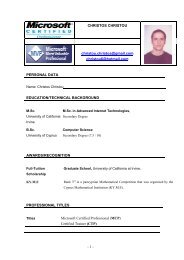Routing Protocols for Ad Hoc Mobile Wireless Networks
Routing Protocols for Ad Hoc Mobile Wireless Networks
Routing Protocols for Ad Hoc Mobile Wireless Networks
Create successful ePaper yourself
Turn your PDF publications into a flip-book with our unique Google optimized e-Paper software.
<strong>Routing</strong> <strong>Protocols</strong> <strong>for</strong> <strong>Ad</strong> <strong>Hoc</strong> <strong>Mobile</strong> <strong>Wireless</strong> <strong>Networks</strong><br />
4.<br />
5.<br />
Conclusion<br />
References<br />
List Of Acronyms<br />
1. Introduction<br />
<strong>Wireless</strong> networks is an emerging new technology that will allow users to access in<strong>for</strong>mation and<br />
services electronically, regardless of their geographic position. <strong>Wireless</strong> networks can be classified in<br />
two types:- infrastructured network and infrastructureless (ad hoc) networks. Infrastructured network<br />
consists of a network with fixed and wired gateways. A mobile host communicates with a bridge in the<br />
network (called base station) within its communication radius. The mobile unit can move geographically<br />
while it is communicating. When it goes out of range of one base station, it connects with new base<br />
station and starts communicating through it. This is called handoff. In this approach the base stations are<br />
fixed.<br />
In contrast to infrastructure based networks, in ad hoc networks all nodes are mobile and can be<br />
connected dynamically in an arbitrary manner. All nodes of these networks behave as routers and take<br />
part in discovery and maintenance of routes to other nodes in the network. <strong>Ad</strong> hoc networks are very<br />
useful in emergency search-and-rescue operations, meetings or conventions in which persons wish to<br />
quickly share in<strong>for</strong>mation, and data acquisition operations in inhospitable terrain[Royer99].<br />
This article discusses proposed routing protocols <strong>for</strong> these ad hoc networks. These routing protocols can<br />
be divided into two categories: table-driven and on-demand routing based on when and how the routes<br />
are discovered. In table driven routing protocols consistent and up-to-date routing in<strong>for</strong>mation to all<br />
nodes is maintained at each node whereas in on-demand routing the routes are created only when desired<br />
by the source host. Next two sections discuss current table-driven protocols as well as on-demand<br />
protocols.<br />
[Back to Table of Contents]<br />
2. Table Driven <strong>Routing</strong> <strong>Protocols</strong><br />
In Table-driven routing protocols each node maintains one or more tables containing routing in<strong>for</strong>mation<br />
to every other node in the network. All nodes update these tables so as to maintain a consistent and<br />
up-to-date view of the network. When the network topology changes the nodes propagate update<br />
messages throughout the network in order to maintain a consistent and up-to-date routing in<strong>for</strong>mation<br />
about the whole network. These routing protocols differ in the method by which the topology change<br />
in<strong>for</strong>mation is distributed across the network and the number of necessary routing-related tables. The<br />
following sections discuss some of the existing table-driven ad hoc routing protocols.<br />
http://www.cis.ohio-state.edu/~jain/cis788-99/adhoc_routing/index.html (2 of 20) [2/7/2000 10:38:34 AM]




